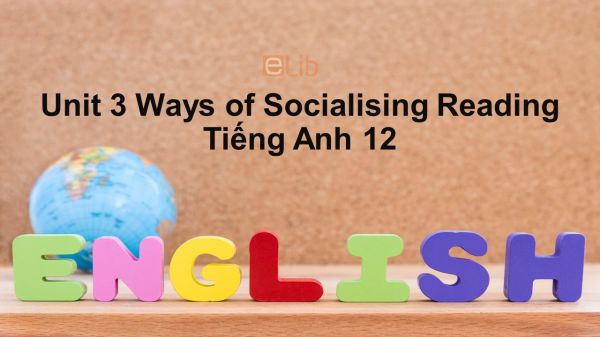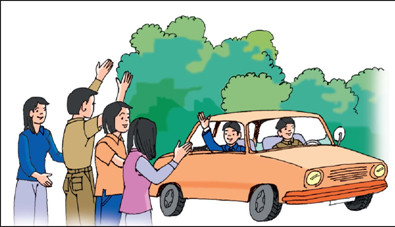Unit 3 lớp 12: Ways of Socialising-Reading
Bài học Unit 3 Lớp 12 Ways of Socialising phần Reading xoay quanh nội dung về các cách giao tiếp trong cuộc sống, qua đó giúp các em học hỏi những kinh nghiệm giao tiếp hàng ngày. Thêm vào đó, nội dung bài học tập trung giúp các em kỹ năng đọc lấy thông tin khái quát và thông tin chi tiết cho vấn đề cần tìm hiểu.
Mục lục nội dung

1. Before You Read Unit 3 lớp 12


1. What are the people in the pictures doing? (Những người trong các bức tranh đang làm gì?)
Guide to answer
In the upper picture, the two men are shaking hands and saying the greetings to each other.
In the lower picture, people are waving and saying "goodbye" to one another.
Tạm dịch
⟹ Trong hình trên, hai người đàn ông đang bắt tay và nói lời chào với nhau.
Trong hình dưới, mọi người vẫy tay chào và nói lời tạm biệt với nhau.
2. What will you do and/or say if (Bạn sẽ làm gì và / hoặc nói nếu)
- you want to get your teacher's attention in class? (bạn muốn thu hút sự chú ý của giáo viên trong lớp)
- you need to ask someone a question, but they are busy talking to someone else? (bạn cần hỏi ai đó một câu hỏi, nhưng họ đang bận nói chuyện với ai đó?)
Guide to answer
- In class to get my teacher’s attention, I usually raise my hand.
- To ask someone a question when they’re busy talking to someone else, I will say to him/ her “I’m sorry. I’d like to talk to you,” or “I'm sorry. I have something to talk to you”, and at the same time I say to their partner “I'm sorry.”
Tạm dịch
⟹ Trong lớp học để thu hút sự chú ý của giáo viên, tôi thường giơ tay lên.
Để hỏi ai đó khi họ đang bận nói chuyện với người khác, tôi sẽ nói với anh ấy / cô ấy "Tôi xin lỗi. Tôi muốn nói chuyện với bạn "hoặc" Tôi xin lỗi. Tôi có một chuyện cần nói với bạn ", và đồng thời tôi nói với đối tác của họ" Tôi xin lỗi. "
2. While You Read Unit 3 lớp 12
Read the passage and do the tasks that follow (Đọc đoạn văn và làm bài tập kèm theo)
To attract someone’s attention so that we might speak to that person, we can use either verbal or non-verbal forms of communication. Let us look at non-verbal communication in English. Probably the most common way of attracting someone’s attention is by waving. For example, if we are at a noisy party and see a friend come in the door about 20 metres away, we might raise our hand and wave to her as a signal that we see her.
But how hard can we wave in a situation like this? Suppose you are at the airport, and you see your brother get off the plane and begin walking toward you. If you are excited, you might jump up and down and wave as hard as you can to attract his attention. This is the instance where big, obvious non-verbal signals are appropriate.
There are, however, some social situations where smaller non-verbal signals are more appropriate. In a restaurant, for example, if we want to attract the attention of our waiter, we have several choices. We can wait until he passes near us, catch his eye, and nod slightly to let him know we would like him to come to our table. Or we can raise our hand slightly to show that we need assistance. We do not whistle or clap our hands to get the person’s attention. That is considered impolite and even rude.
In most social situations where some informality is allowed, a brief raise of the hand and a small wave is fine. For instance, if you are walking across the schoolyard and see your teacher approaching you, a small friendly wave to attract his or her attention is appropriate.
Once you’ve got your friend’s attention, you shouldn’t point at the person or thing you want her to look at. A slight nod will do. Pointing at someone is usually considered rude. Of course, there are times when pointing is perfectly acceptable, such as when a teacher wants to get someone’s attention in class. The teacher often points to the student and says, “David, would you read the next sentence, please?” Pointing here is not impolite; it’s simply a way to get someone’s attention.
Tạm dịch bài đọc
Để thu hút sự chú ý của một người nào đó để chúng ta có thể nói với người ấy, chúng ta có thể dùng những hình thức giao tiếp bằng lời hoặc không bằng lời. Chúng ta hãy nhìn vào cách giao tiếp không bằng lời ở tiếng Anh. Có lẽ cách thông thường nhất để thu hút sự chú ý của một người là vẫy tay. Chẳng hạn, nếu chúng ta đang dự một bữa tiệc náo nhiệt và gặp một người bạn đứng ở cửa cách xa khoảng 20 m, chúng ta có thể giơ tay và vẫy cô ấy như một dấu hiệu cho biết chúng ta thấy cô.
Nhưng trong tình huống như thế này chúng ta có thể khó vẫy tay biết bao? Giả sử bạn đang ở sân bay, và bạn thấy anh bạn xuống máy bay và bắt đầu đi về hướng bạn. Nếu bạn mừng rỡ, bạn có thể nhảy cẩng lên và vẫy tay liên tục bạn có thể để thu hút sự chú ý của anh ấy. Đây là tình huống mà những kí hiệu không bằng lời hiển nhiên là thích hợp.
Nhưng có vài tình huống giao tiếp mà những hình thức gây chú ý không bằng lời nhẹ nhàng hơn lại thích hợp hơn. Chẳng hạn, trong một nhà hàng, nếu chúng ta muốn thu hút chú ý của một nhân viên phục vụ, chúng ta có nhiều sự lựa chọn. Chúng ta có thể chờ cho đến khi người đó đi qua, nhìn vào mắt anh ấy, và gật đầu nhẹ để cho anh biết chúng ta muốn anh đến với bàn cùa chúng ta. Hoặc chúng ta có thể nhẹ nhàng giơ tay để cho biết chúng ta cần sự giúp đỡ. Chúng ta không huýt sáo hay vỗ tay để gây sự chú ý của người khác. Điều đó được xem vô lễ và thậm chí là thô lỗ.
Trong hầu hết các tình huống giao tiếp sự thân mật cho phép, đưa tay lên một cách nhanh chóng và vẫy tay nhẹ nhàng cũng đủ. Chẳng hạn, nếu bạn đi ngang sân trường và thấy giáo viên của bạn đang tiến đến, cái vẫy tay thân mật nhẹ nhàng để gây sự chú ý của thầy /cô ấy là thích hợp.
Một khi bạn đã gây được chú ý của bạn mình, bạn không nên chỉ vào người hay vật bạn muốn anh / chị ấy nhìn vào. Một cái gật đầu nhẹ là đủ. Chỉ vào ai thường được xem là vô lễ. Dĩ nhiên có nhiều lúc sự chỉ trỏ hoàn toàn có thể chấp nhận, như khi giáo viên muốn sự chú ý của người nào trong lớp. Giáo viên thường chỉ vào học sinh đó và nói. "David, em vui lòng đọc câu tiếp theo." Sự chỉ ở đây không phải vô lễ, đơn thuần là cách gây sự chú ý của một người.
2.1. Task 1 Unit 3 lớp 12
Give the Vietnamese equivalent to the following words and phrases (Cho từ tương đương tiếng Việt của những từ và cụm từ sau)
- verbal: bằng lời nói
- rude: vô lễ
- non-verbal: không bằng lời nói
- informality: sự/tính thân mật
- approach: đến gần
- attract some's attention: thu hút sự chú ý của ai
- attention getter: cử chỉ gây sự chú ý
- a light nod will do: cái gật đầu nhẹ là đủ.
2.2. Task 2 Unit 3 lớp 12
Decide which of the three options below is the best title for the passage (Quyết định sự chọn lựa nào trong ba chọn lựa dưới đây là lựa thích hợp nhất cho đoạn văn.)
A. Attracting Attention: Non-verbal Cues
B. Attracting Attention by Waving
C. The Best Ways of Attracting Attention
Guide to answer
Giải thích: Đoạn 1 "Let us look at non-verbal communication in English"
Sau đó nội dung của của bài đề cập đến phương thức giao tiếp không qua lời nói (non-verbal communication)
⇒ Đáp án A
B sai: cử chỉ vẫy tay chỉ có ở đoạn số 2, chứ không phải nội dung cả bài
C sai: vì các cách thu hút sự chú ý chỉ có trong đoạn số 3
Tạm dịch
A. Thu hút sự chú ý: những ám hiệu không lời
B. Thu hút sự chú ý bằng cách vẫy
C. Cách tốt nhất để thu hút sự chú ý
2.3. Task 3 Unit 3 lớp 12
Answer the following questions (Trả lời các câu hỏi sau)
Guide to answer
1. What can we do when we want to attract someone’s attention?
⇒ When we want to attract someone’s attention, we can use either verbal or non-verbal communication.
Tạm dịch
1. Chúng ta có thể làm gì khi muốn thu hút sự chú ý của ai đó?
⇒ Khi chúng ta muốn thu hút sự chú ý của ai đó, chúng ta có thể sử dụng giao tiếp bằng lời nói hoặc không bằng lời nói.
2. What are considered to be big, obvious non-verbal signals?
⇒ They are strong gestures that can he easily seen in the distance.
Tạm dịch
2. Những gì được coi là tín hiệu phi ngôn rõ ràng và lớn?
⇒ Đó là những cử chỉ mạnh mẽ mà anh ta có thể dễ dàng nhìn thấy ở xa.
3. What can we do if we want to attract the waiter’s attention?
⇒ If we want to attract a waiter’s attention, we can wait until he passes near us, catch his eyes and nod slightly to let him know we would like him to come to our table. Or we can raise our hand slightly to show we need assistance.
Tạm dịch
3. Chúng ta có thể làm gì nếu muốn thu hút sự chú ý của người bồi bàn?
⇒ Nếu chúng ta muốn thu hút sự chú ý của một người bồi bàn, chúng ta có thể đợi cho đến khi anh ta đi gần chúng tôi, bắt mắt anh và gật đầu nhẹ để cho anh ta biết chúng tôi muốn anh ta đến bàn của chúng tôi. Hoặc chúng ta có thể giơ tay lên để cho thấy chúng ta cần sự trợ giúp.
4. If you are walking across the schoolyard and see your teacher approaching you, what can you do to attract his or her attention?
⇒ We can use a small friendly wave to attract his / her attention.
Tạm dịch
4. Nếu bạn đang đi bộ qua sân trường và thấy thầy giáo đang tiếp cận bạn, bạn có thể làm gì để thu hút sự chú ý của mình?
⇒ Chúng ta có thể sử dụng một làn sóng nhỏ thân thiện để thu hút sự chú ý của mình.
5. Why shouldn't you point at the person or thins you want your friend to look at once you’ve got his or her attention?
⇒ Because this action is usually considered rude.
Tạm dịch
5. Tại sao bạn không nên chỉ vào người hoặc thins bạn muốn bạn của bạn để xem xét một khi bạn đã có sự chú ý của mình?
⇒ Bởi vì hành động này thường được coi là thô lỗ.
3. After You Read Unit 3 lớp 12
Work in pairs. Discuss the meanings of whistling and hand-clapping in Vietnamese culture (Làm việc từng đôi. Thảo luận ý nghĩa của huýt sáo và vỗ tay theo văn hóa Việt Nam)
Guide to answer
A: Do you think whistling and hand-clapping convey different meanings?
B: Sure. These two actions have quite different meanings. I think whistling is a signal to show we feel happy or satisfied with something.
A: But teenagers, at present, whistle to express their disapproval or protest.
B: OK. But only for teenagers. To adults or learned or educated people, they never whistle to show their disapproval or dissatisfaction.
A: That’s right. Whistling in crowds is considered impolite or even rude.
B: What about hand-clapping?
A: In my opinion, hand-clapping is a action used to show one's approval, aurcement or enjoyment.
B: But I've heard there is a different meaning between common hand-clapping and slow hand-clapping.
A: Sorry, I'm not much sure, but as I know slow hand-clapping shows the applause or cheer.
B: However slow hand-clapping with shouts can be used to express strong disapproval or protest.
A: Thus, we should be careful when we clap our hands.
B: Well, I think so.
Tạm dịch
A: Bạn có nghĩ huýt sáo và vỗ tay diễn tả những ý nghĩa khác nhau?
B: Chắc chắn. Hai hành động này có ý nghĩa khá khác nhau. Tôi nghĩ huýt sáo là một tín hiệu cho thấy chúng ta cảm thấy hạnh phúc hoặc hài lòng với một cái gì đó.
A: Nhưng hiện nay, thanh thiếu niên, huýt sáo để bày tỏ sự phản đối hoặc không đồng tình của họ.
B: Đồng ý. Nhưng chỉ dành cho thanh thiếu niên. Đối với người lớn hoặc người học hoặc người có giáo dục, họ không bao giờ huýt sáo để cho thấy sự không chấp thuận hoặc không hài lòng của họ.
A: Đúng thế. Tiếng huýt sáo trong đám đông được coi là bất lịch sự hoặc thậm chí thô lỗ.
B: Còn vỗ tay thì sao?
A: Theo tôi, vỗ tay là một hành động được sử dụng để thể hiện sự chấp thuận, sự đồng tình hoặc thích thú của một người.
B: Nhưng tôi đã nghe có một ý nghĩa khác nhau giữa vỗ tay thông thường và vỗ tay chậm.
A: Xin lỗi, tôi không chắc lắm, nhưng như tôi biết, vỗ tay chậm rãi cho thấy sự tán thưởng hay cổ vũ.
B: Tuy nhiên việc vỗ tay chậm bằng tiếng hét có thể được sử dụng để thể hiện sự phản đối hoặc chống đối mạnh mẽ.
A: Vì vậy, chúng ta nên cẩn thận khi chúng ta vỗ tay.
B: À, tôi nghĩ thế.
4. Practice Task 1
Choose a, b, c, or d that best completes each unfinished sentence, substitutes the underlined part, or has a close meaning to the original one (Chọn câu a, b, c hay d phù hợp nhất để hoàn thành các câu sau)
1. She is a kind of woman who does not care much of work but generally _______ only with colleagues for meals, movies or late nights at a club.
a. supposes b. socializes c. attention d. discussed
2. I didn't think his comments were very appropriate at the time.
a. correct b. right c. exact d. suitable
3. You should _______ more attention to what your teacher explains.
a. make b. get c. set d. pay
4. Body language is a potent form of _______ communication.
a. verbal b. non-verbal c. tongue d. oral
5. Our teacher often said, "Who knows the answer? _______ your hand."
a. Rise b. Lift c. Raise d. Heighten
5. Practice Task 2
Read the passage carefully and choose the correct answer (Đọc bài văn và chọn câu trả lời đúng)
Communication in general is process of sending and receiving messages that enables humans to share knowledge, attitudes, and skills. Although we usually identify communication with speech, communication is composed of two dimensions - verbal and nonverbal.
Nonverbal communication has been defined as communication without words. It includes apparent behaviors such as facial expressions, eyes, touching, tone of voice, as well as less obvious messages such as dress, posture and spatial distance between two or more people.
Activity or inactivity, words or silence all have message value: they influence others and these others, in turn, respond to these communications and thus they are communicating.
Commonly, nonverbal communication is learned shortly after birth and practiced and refined throughout a person's lifetime. Children first learn nonverbal expressions by watching and imitating, much as they learn verbal skills.
Young children know far more than they can verbalize and are generally more adept at reading nonverbal cues than adults are because of their limited verbal skills and their recent reliance on the nonverbal to communicate. As children develop verbal skills, nonverbal channels of communication do' not cease to exist although become entwined in the total communication process.
1. According to the writer, ________.
a. Nonverbal language is only used by the deaf and the mute.
b. One cannot communicate in both verbal and . nonverbal language.
c. Those who can listen and talk should not use nonverbal language.
d. People communicate with both verbal and nonverbal language.
2. Which is not included in nonverbal communication?
a. words b. spatial distance
c. facial expressions d. tone of voice
3. We can learn from the text that ________.
a. nonverbal can never get any responses
b. most people do not like nonverbal communication
c. even silence has message value
d. touching is not accepted in communicating
4. Human beings ________.
a. have learnt how to communicate in nonverbal language through books
b. can communicate in nonverbal language only when they are mature
c. have learnt how to communicate in nonverbal language since a child
d. communicate in nonverbal language much less than they do in verbal language
5. The word reading has a close meaning to ________.
a. looking at the words that are written
b. understanding
c. saying something aloud
d. expressing
5. Conclusion
Qua bài học này, các em cần ghi nhớ một số từ vựng quan trọng trong bài học như sau
- social ['sou∫l] (adj): thuộc xã hội
- to attract sb’s attention [ə'trækt] [ə'ten∫n] (v): gây (thu hút) sự chú ý của ai
- verbal ['vəbl] (adj): bằng lời, hữu ngôn
- non - verbal (adj): phi ngôn
- formal ['fɔrml] (adj): trịnh trọng
- informal [in'fɔml] (adj) = friendly: thân mật
- nod [nɑd] (v): gật đầu
- approach [ə'prout∫] (v): lại gần, đến gần
- communication [kə,mjuni'kei∫n] (n): sự giao tiếp
- common ['kɑmən] (adj): thông thường, phổ biến
- to wave [weɪv] (v): vẫy tay
- to raise one’s hands: giơ tay
- signal ['signəl] (n): dấu hiệu
- to get off (v): xuống (xe) # to get on
- to be excited [ɪk'saɪtɪd] (v): phấn khích
- to jump up and down [dʒʌmp] (v): nhảy lên
- instance ['instəns] (n): trường hợp
- for instance: ví dụ, chẳng hạn
- obvious ['ɒbviəs] (adj): rõ ràng, hiển nhiên
- appropriate [ə'proupriət] (adj): thích hợp
- choice [t∫ɔis] (n): sự lựa chọn
- to pass (v) [pæs]: đi ngang qua
- to catch one’s eye [kæʧ] (v): gặp ánh mắt của ai
- slightly [‘slaitli] (adj): nhẹ nhàng
- to whistle [wisl] (v): húyt sáo
- to be rude to sb [kæʧ] (adj): khiếm nhã, bất lịch sự với ai
Tham khảo thêm
- doc Unit 3 lớp 12: Ways of Socialising-Speaking
- doc Unit 3 lớp 12: Ways of Socialising-Listening
- doc Unit 3 lớp 12: Ways of Socialising-Writing
- doc Unit 3 lớp 12: Ways of Socialising-Language Focus



